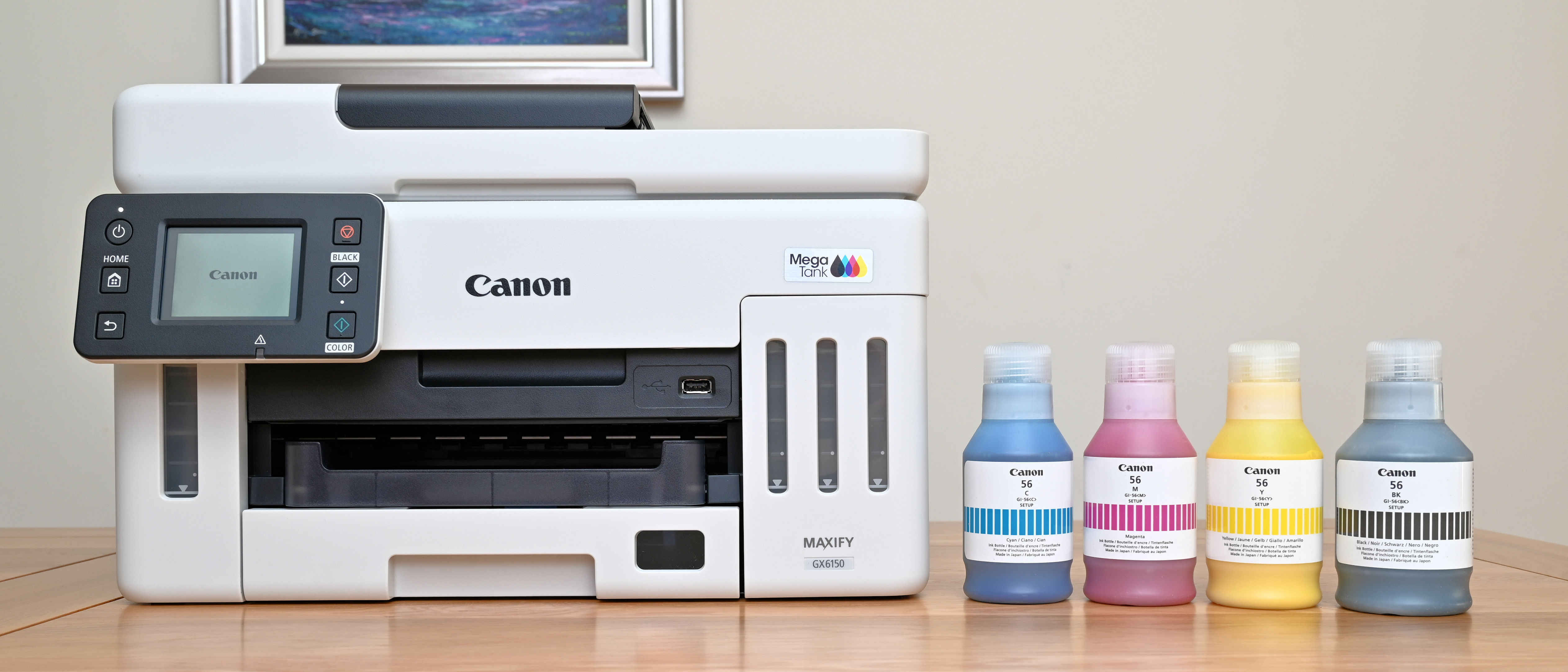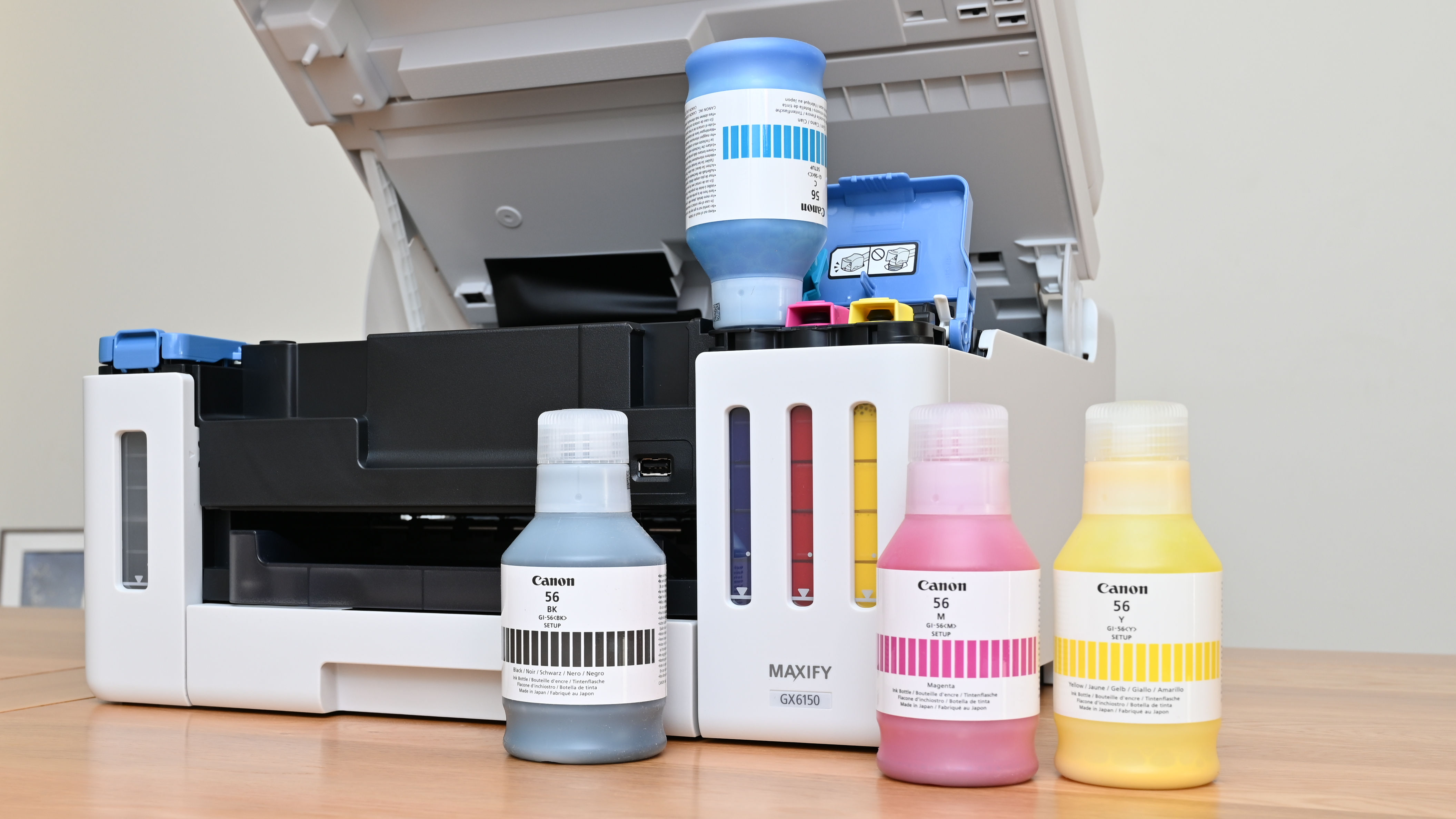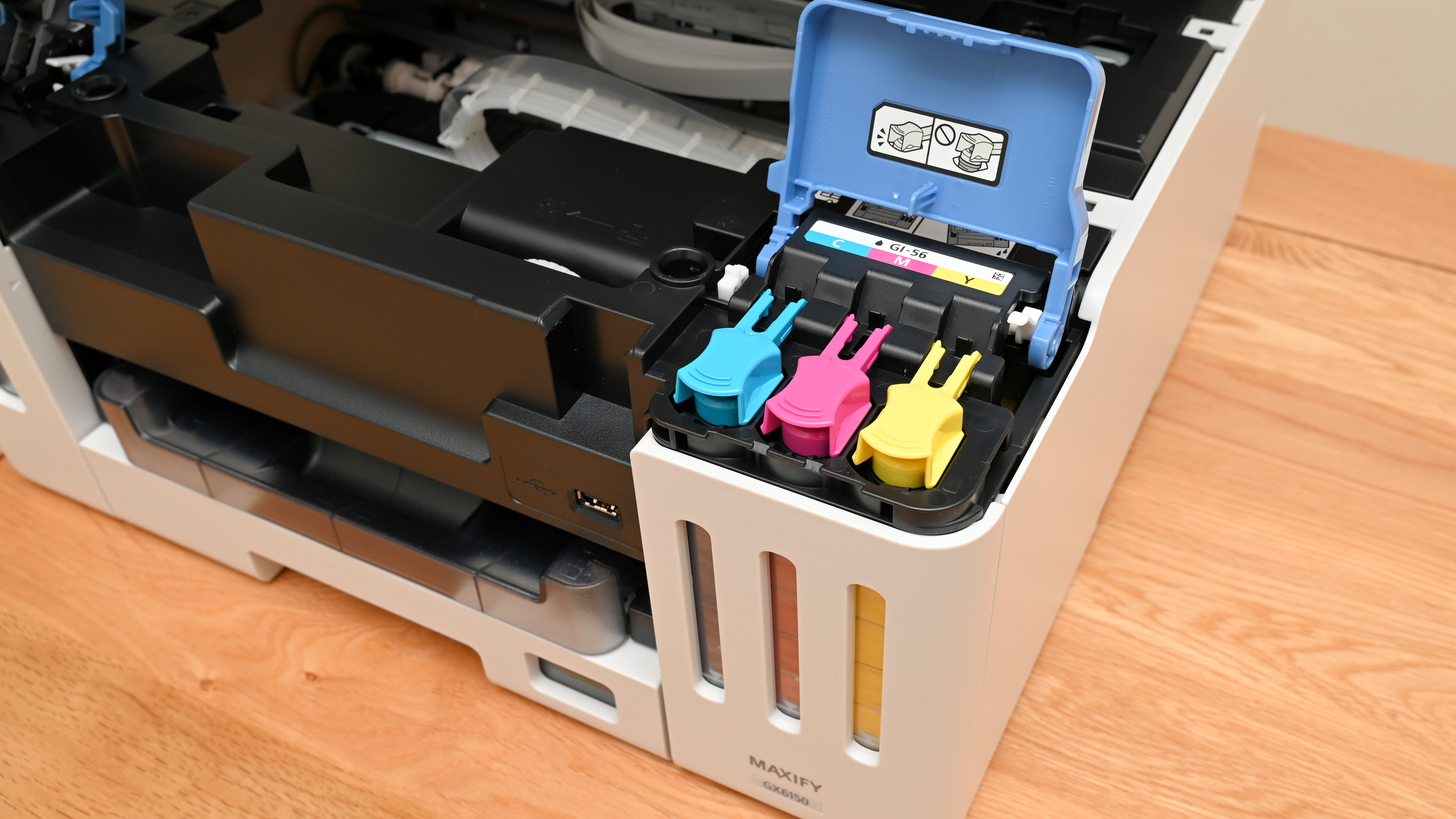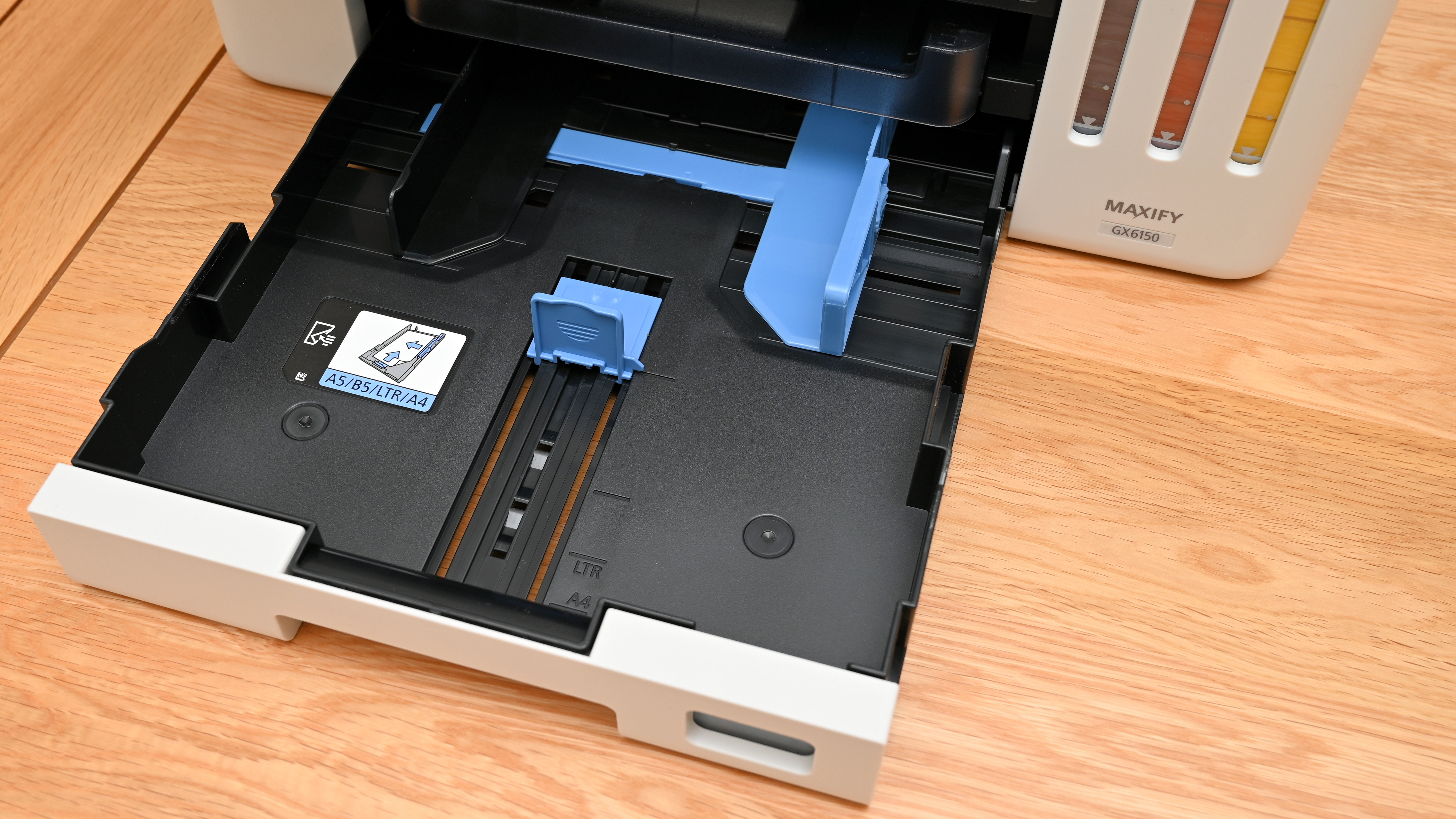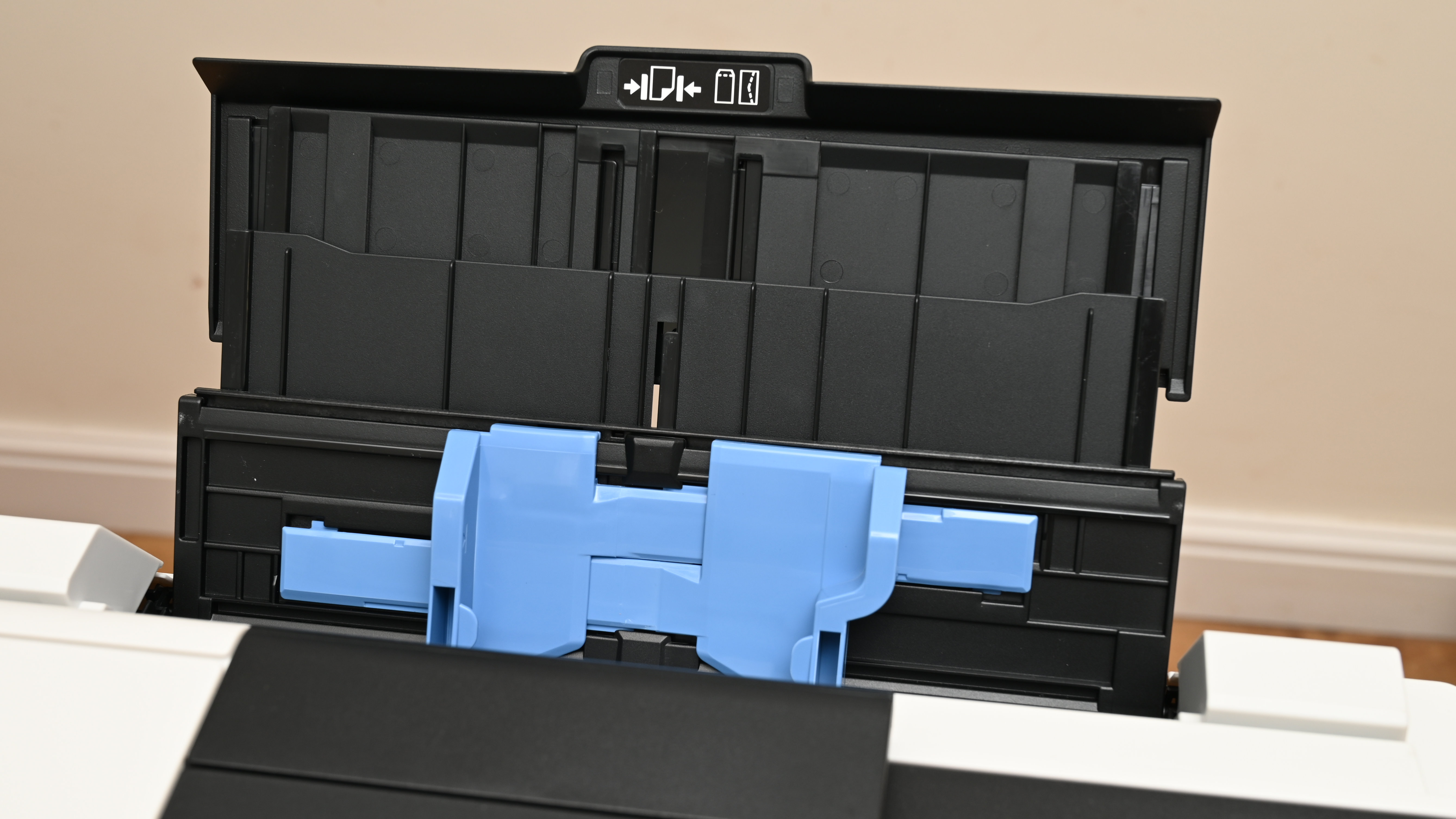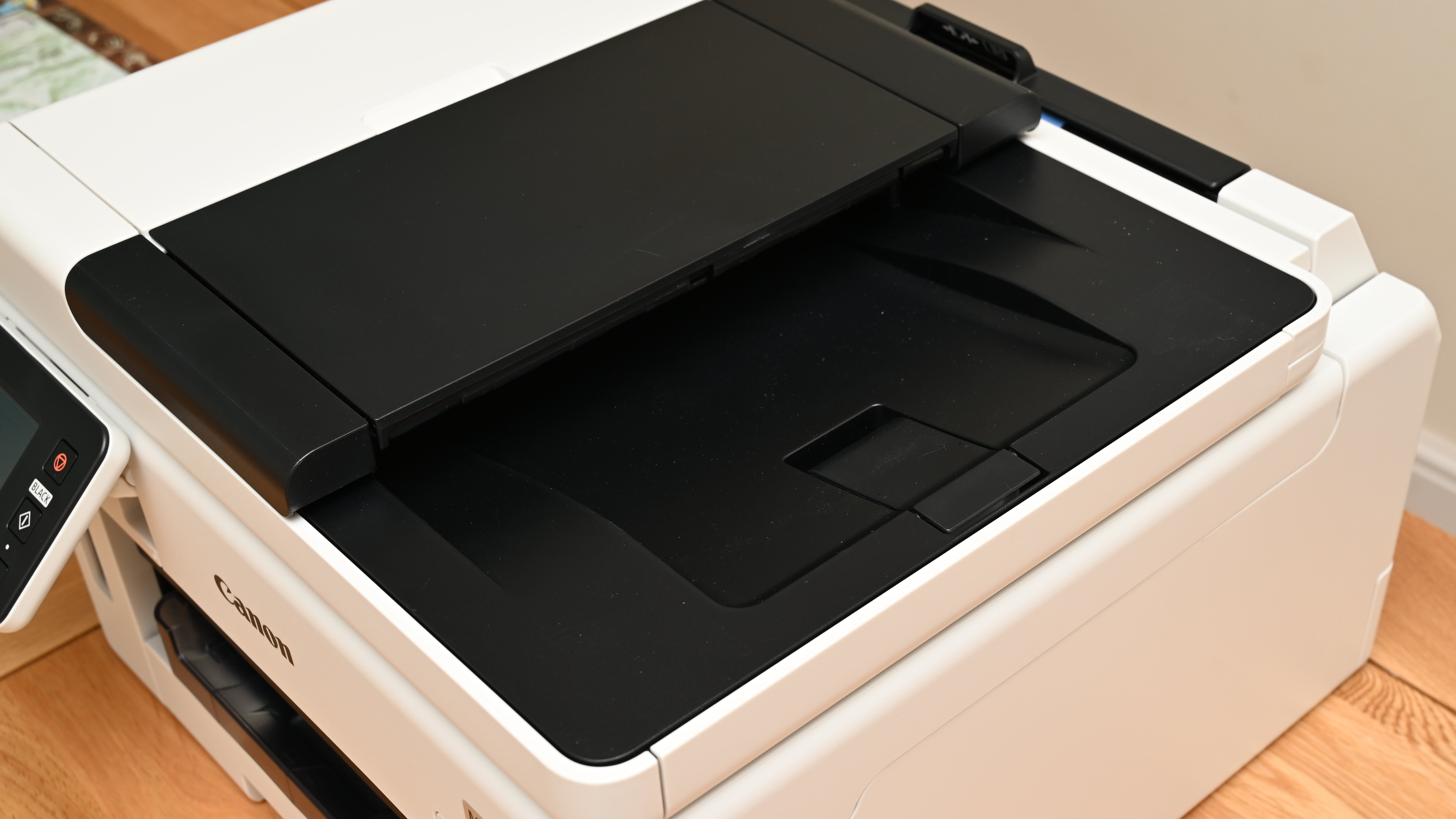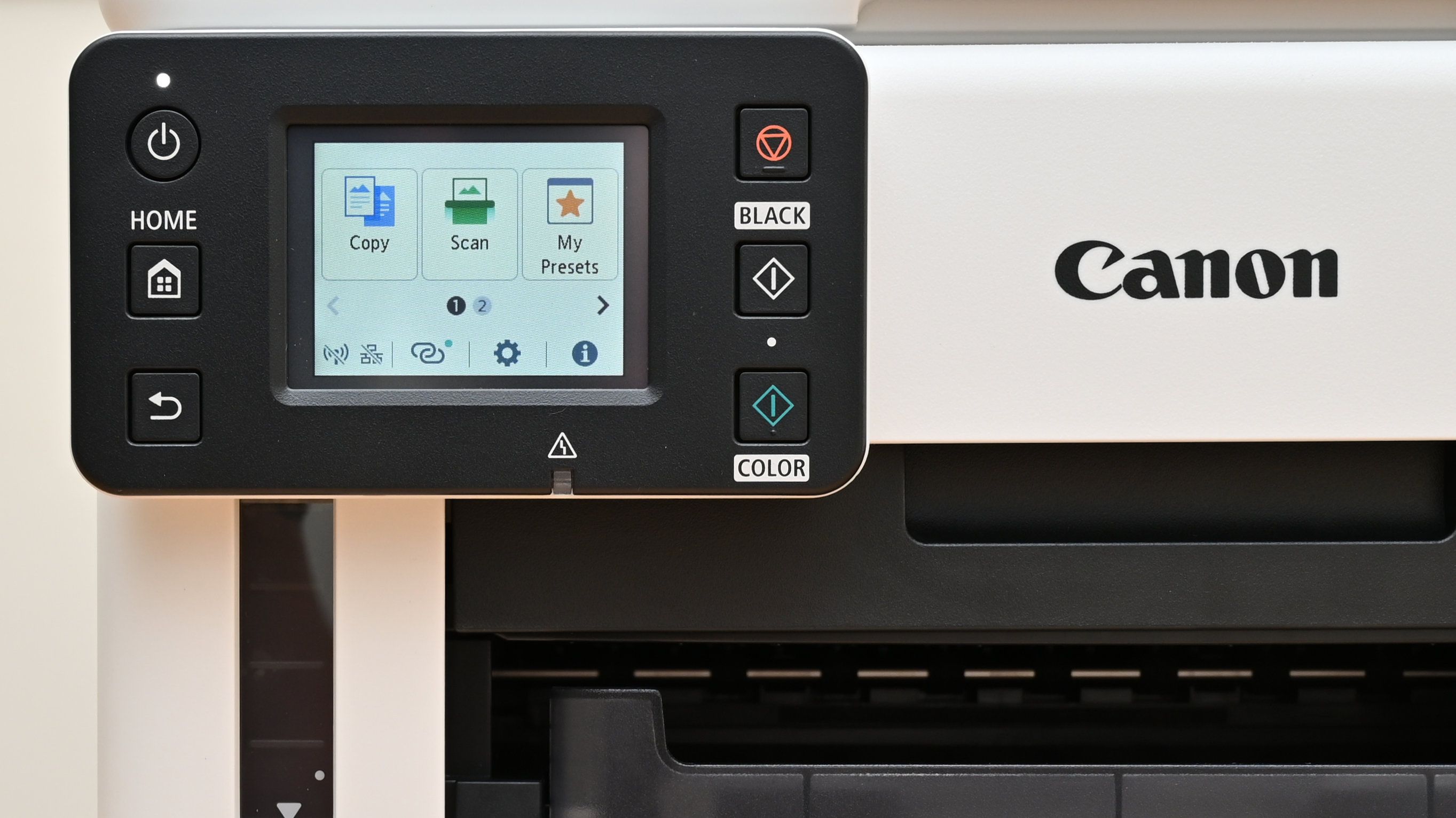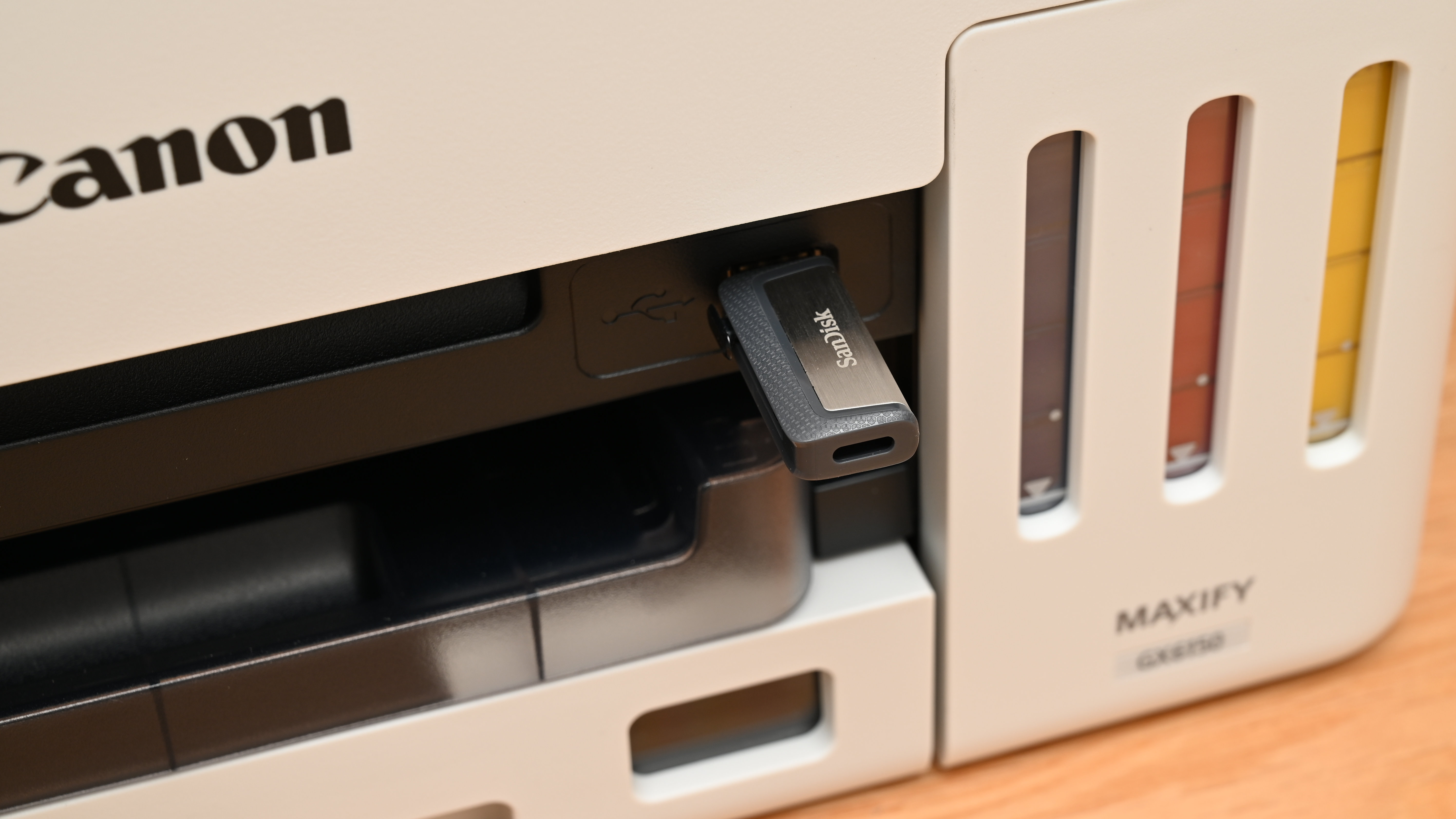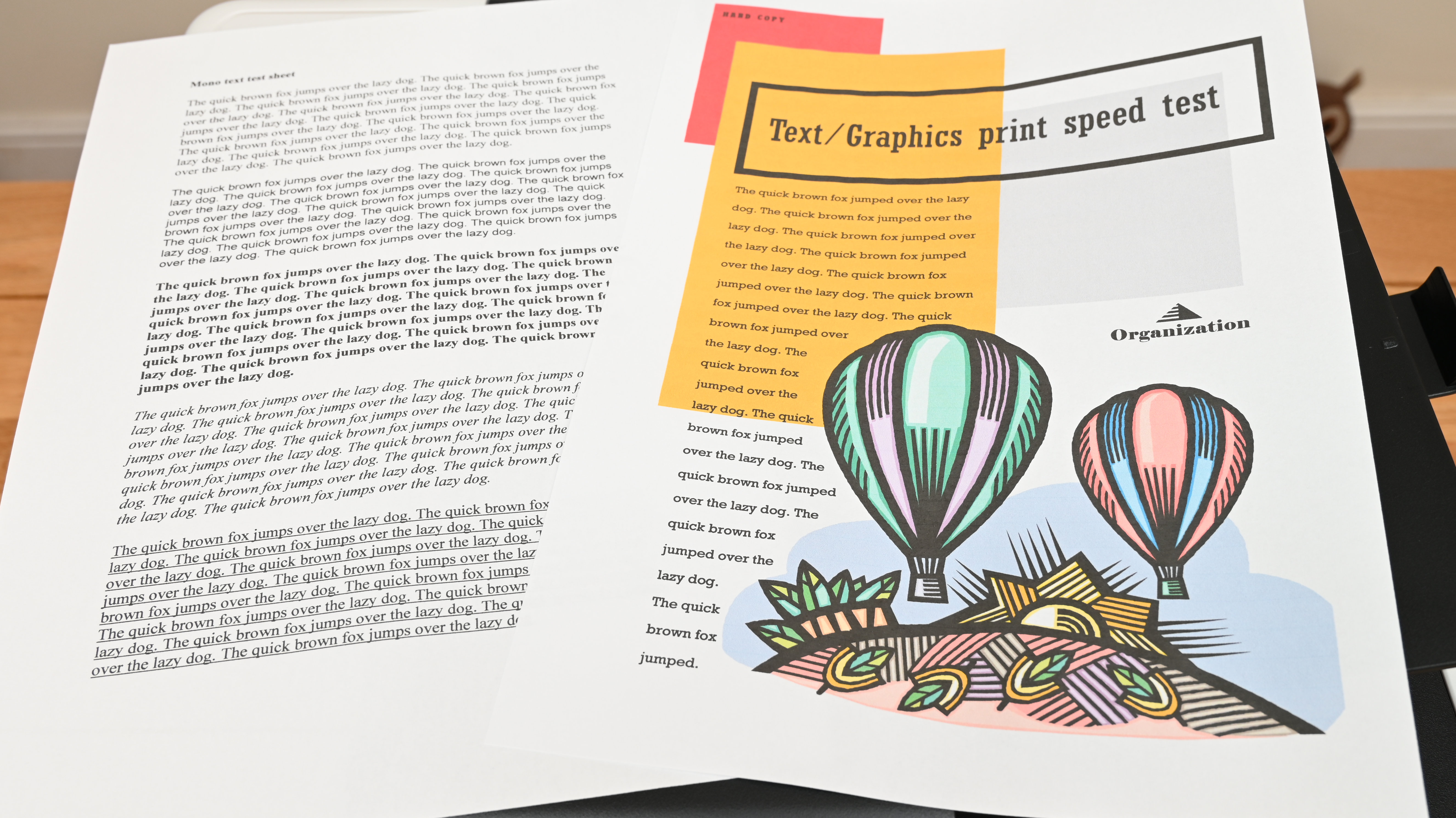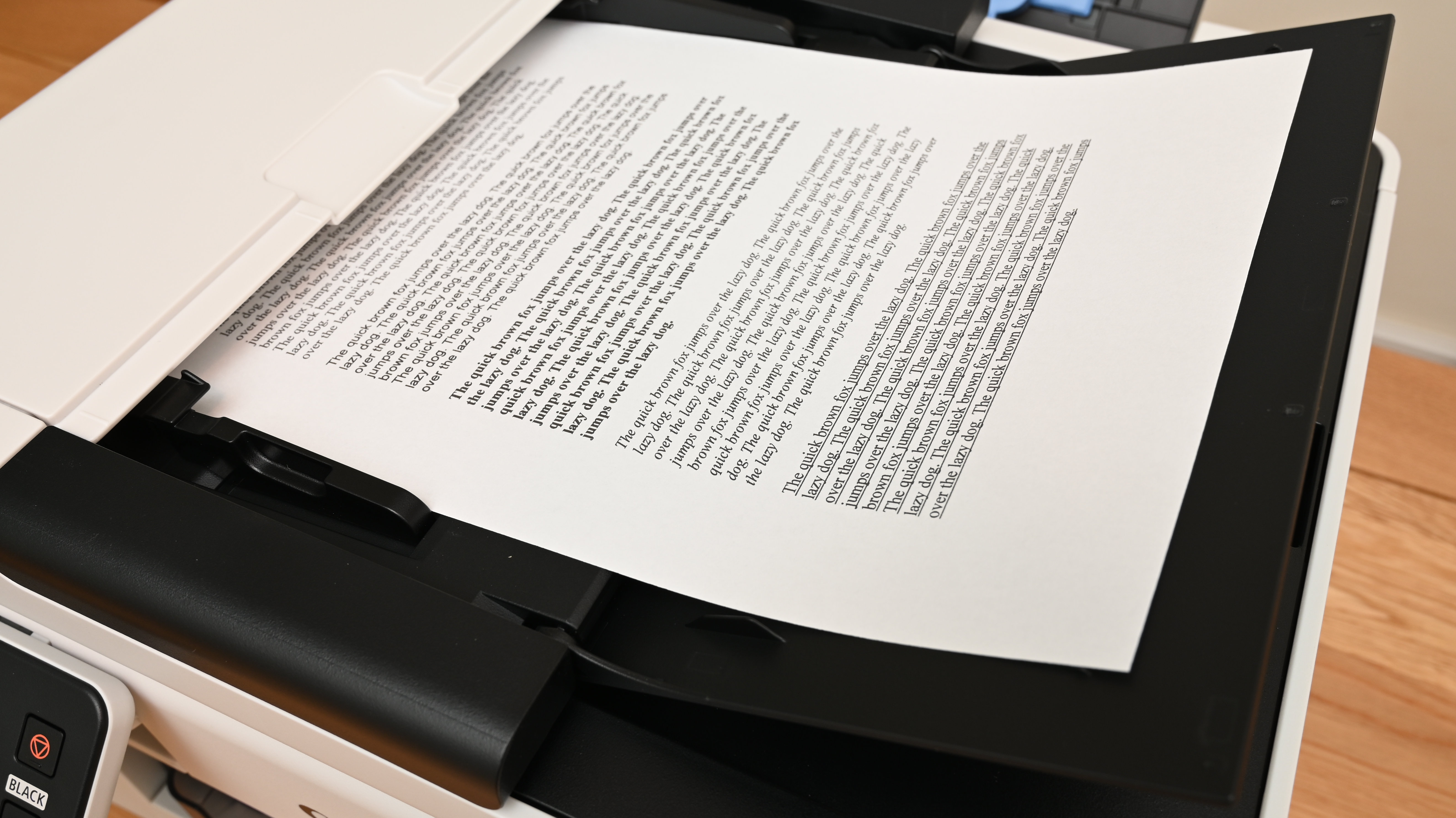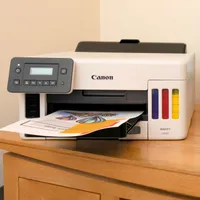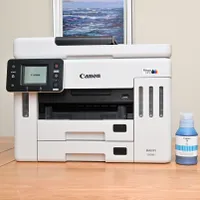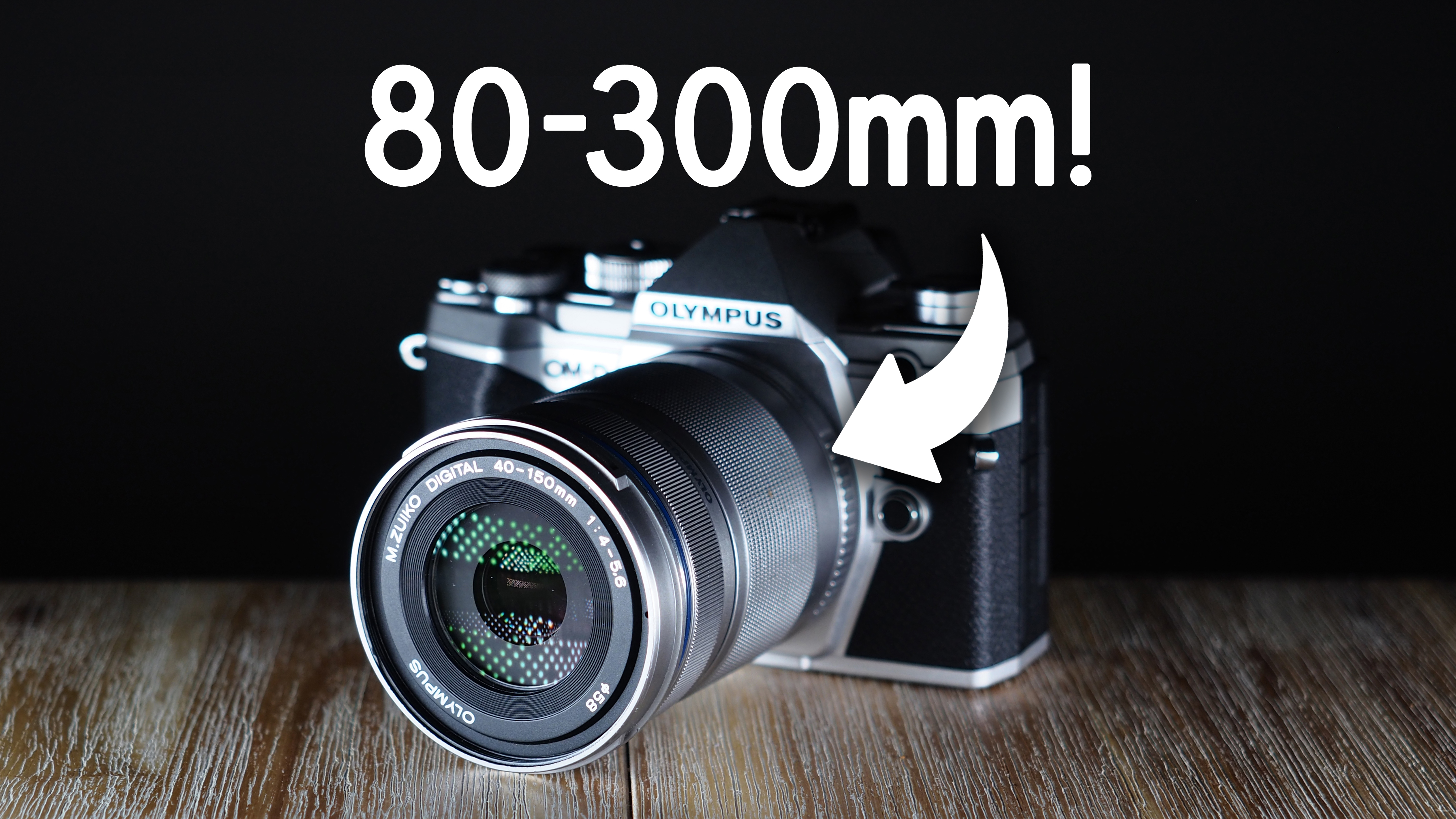Digital Camera World Verdict
The Canon Maxify GX6120 / GX6150 is fast and highly capable for mono and color document printing. I like that its pigment-based inks are very smudge-resistant on plain paper, although they’re less ideal for glossy photo output. It’s a pricey printer to buy but works out relatively cheap in the long run for high-volume printing, ideal for the home/small office.
Pros
- +
Fast, high-quality document printing
- +
Durable pigment-based inks
- +
Low running costs
- +
Enhanced connectivity and security
Cons
- -
No auto duplex scanning
- -
No direct fax
- -
Not great for glossy photos
- -
Minimal changes from previous model
Why you can trust Digital Camera World
Typical of Canon’s Maxify ‘MegaTank’ printers, this one claims to save you around 90 per cent on the total cost of ownership, compared with leading laser and inkjet printers. That’s thanks to it running on relatively large tanks that are replenished by bottles of ink, rather than expensive, small-capacity ink cartridges.
Naturally, from a business perspective, there are also savings in time, effort and money if you only have to buy bottles of ink occasionally instead of ordering cartridges on a frequent basis. Indeed, a single set of bottles (as supplied with the printer) should see you through 6,000 mono and 14,000 color document pages, and up to 9,000 mono and 21,000 color in Economy print mode.
With its reasonably compact build, this Canon aims to be one of the best inkjet printers for the small office or home office, as well as for retail outlets, schools and more besides.
Canon Maxify GX6120 / GX6150: Specifications
Inks/type | 4x pigment, CMYK |
Max print size | 8.5x14-inch/A4, letter, legal |
Max print speed | 24 ipm mono, 15.5 ipm color |
Max print resolution | 600x1200dpi |
Input trays | 1 front (250 sheets), 1 rear (100 sheets) |
Scanner | 1200x1200dpi, 50-sheet ADF |
Display screen | 2.7-inch color touchscreen |
Interfaces | 2x USB, Wi-Fi, Ethernet |
Dimensions (WxDxH) | 399x410x254mm / 16.2x15.8x10" |
Weight | 11.6kg / 25.6lb |
Canon Maxify GX6120 / GX6150: Price
This printer is sold as the Maxify GX6120 in the USA, and as the GX6150 in Europe, and as the Canon Maxify GX6160 in Australia. As I’m tapping in the numbers, purchase prices vary considerably at different retailers, from $449 to $699 in the USA and from £566 to £645 in the UK, so it pays to shop around. Taking the long view, cheap running costs dramatically reduce the total cost of ownership for high-volume printing, with long-lasting ink bottles costing around $27 / £14 for black and $32 / £20 for each of the three cyan, magenta and yellow colors.
Canon Maxify GX6120 / GX6150: Design & Handling
Good for business, the Maxify GX6120 / GX6150 is designed to pack high-volume printing into a small build. Canon says it should fit right in with real estate agencies, retail outlets, private clinics, educational establishments and a host of other environments. With hybrid working still being on the agenda, I can see it finding a place in the busy home office as well.
The fundamental design principle is that ink tanks are replenished by bottles, banishing pricey and frequently replaced ink cartridges. The flipside is that if you only print documents occasionally, a cartridge printer with a much lower initial purchase price will be a better fit financially, while a printer that runs on dye-based inks rather than this one’s pigment-based inks will be far superior for creating glossy photos.
Back with my business hat on, I feel that this printer has all the same advantages as the preceding Canon Maxify GX 6020 / GX6050. In fact, the two generations look pretty much identical, not only physically but also in the vast majority of features and specifications. The main upgrade reflects changes in working practices, with many of us now working across different locations and in shared office spaces. With that in mind, wireless connectivity has been enhanced for greater stability, and security has been upgraded to include TLS1.3 and WPA3-Personal protocols.
The best camera deals, reviews, product advice, and unmissable photography news, direct to your inbox!
I like that despite being a high-speed, high-volume printer, the Canon is compact and lightweight. It measures 399x410x254mm (16.2x15.8x10") with the trays retracted and weighs in at 11.6kg / 25.6lb. Ensuring its suitability for the small office or home office, it definitely fits into small spaces. I also like that it has two full-sized paper input options. The main one is an internal cassette that slots into the front of the printer and holds up to 250 sheets of paper. The upright rear tray holds 150 sheets of plain paper, but it makes sense to me to use this for specialist media as and when needed, like letterheaded paper or photo paper. You can also use the rear tray for long media, creating banners up to 1.2m / 47” in length.
There’s yet another input tray, in the shape of a 50-sheet ADF (Auto Document Feeder) up on top of the printer. This one is for the built-in scanner, which has an impressive maximum optical resolution of 1200x1200dpi (dots per inch). Unlike in the more expensive Maxify GX7120 / GX7150, it’s only a simplex rather than a duplex scanner, so if you want to scan double-sided documents you’ll need to do it manually.
Naturally, the built-in scanner brings standalone options to the table, or whatever else you’re standing the printer on. Typically, you can use the printer for copying as well as scanning but there’s no direct fax facility. Standalone functions are neatly brought together by a 2.7-inch color touchscreen display, which is logical and intuitive in use.
As I’ve mentioned, enhanced connectivity and security are the main upgrades from the previous model. Connectivity options include wired LAN and dual-band 2.4GHz / 5GHz Wireless LAN, with a comprehensive range of protocols and security options. You can scan and print to or from the cloud, with Cloud Link, Canon Print Service Plugin (Android), Apple AirPrint, Wireless Direct Connection and Mopria (Android). There’s also support for Amazon Alexa and mobile apps including Canon PRINT Inkjet/SELPHY and Easy-PhotoPrint Editor. All in all, it takes far-flung connections with remote co-workers and clients fully onboard, and you can also scan directly to email or network folders, or to a USB stick thanks to a USB socket on the front panel
Canon Maxify GX6120 / GX6150: Performance
The maximum print resolution of 600x1200dpi enables crisp and sharp documents in both mono and color printing, right down to the smallest small print and the likes of barcodes and QR codes. Black text is deep and strong, while color rendition is good on plain paper. Thanks to the formulation of the pigment-based inks, prints are durable and resistant to smudging, not only for the likes of taking envelopes to the postbox in a rain shower, but also for using highlighters to make mark-ups. There’s also less bleed through on plain paper for double-sided printing, compared with many dye-based inkjet printers that I’ve used, and it’s useful that the printer has an auto duplex facility for printing, if not for scanning.
While the pigment-based inks are a top choice for document printing on plain paper, they’re less than ideal for photo printing on glossy paper. As expected, the relatively large molecules of pigment don’t fully sink through the top shiny layer of glossy photo paper, like dye-based inks do, and the results look second-best. Even so, and also taking into account the relatively limited 4-ink line-up for photo printing, the printer does a passable job of photo printing. There’s certainly wide-ranging support in the printer driver for paper types including gloss, semi-gloss and matte photo papers as well as re-stickable photo paper, magnetic photo paper and fabric iron-on transfers.
In terms of print speeds, the printer lived up to its claims in my tests. Mono text documents print at up to 24ipm (impressions per minute) and it’s 15.5ipm for color. That’s pretty impressive, as is the first page print out time of 5.5 seconds for mono and 7 seconds for color, when the printer is switched on and fully ready to roll. Scanning speeds are up to 22.2ipm for mono and 16.9ipm for color, with copying available at speeds of up to 22.2ipm for mono and 12.2ipm for color. Further copying options include manual duplex, 2-on-1 and 4-on1 copies, collated copies with the ADF, ID card copying, and reduction/enlargements with a range of 25-400 per cent. All in all, the Canon is a top performer.
Canon Maxify GX6120 / GX6150: Verdict
I feel that the Canon Maxify GX6120 / GX6150 is an easy printer to live with. It’s simple to set up yet offers a wide range of connectivity, printing, scanning and copying options, all brought together by an intuitive color touchscreen. It’s fast and highly capable, delivering excellent print quality for both mono and color documents. Sure, it doesn’t have a direct fax facility nor auto duplex scanning (only printing) but these aren’t features that I really need anyway. It’s pretty pricey to buy but the cheap running costs means I’ll break even sooner rather than later, and it saves the chore of frequent ink cartridge replacements. For the busy home or small office, this printer is a top contender.
Features ★★★★☆ | Bottle-feeding, ADF scanning and robust document printing are top features, but there’s no duplex scanning nor direct fax. |
Design ★★★★★ | Typical of Canon printers, this one is easy and intuitive to use and has very good build quality. |
Performance ★★★★★ | It’s very fast for mono and color printing, scanning and copying, with excellent document quality. |
Value ★★★★☆ | It’s pricey to buy but if you need to print in large quantities, you’ll make big savings. |
Alternatives
The Canon Maxify GX5020 / GX5050 / GX5060 is a similarly bottle-fed printer that’s equally cheap to run but it’s also cheaper to buy. That’s mainly because it’s a printer pure and simple, with no built-in scanner and only a basic mono info screen. If you don’t need scanning or copying, it’s a money-saving option.
Matthew Richards is a photographer and journalist who has spent years using and reviewing all manner of photo gear. He is Digital Camera World's principal lens reviewer – and has tested more primes and zooms than most people have had hot dinners!
His expertise with equipment doesn’t end there, though. He is also an encyclopedia when it comes to all manner of cameras, camera holsters and bags, flashguns, tripods and heads, printers, papers and inks, and just about anything imaging-related.
In an earlier life he was a broadcast engineer at the BBC, as well as a former editor of PC Guide.
You must confirm your public display name before commenting
Please logout and then login again, you will then be prompted to enter your display name.
